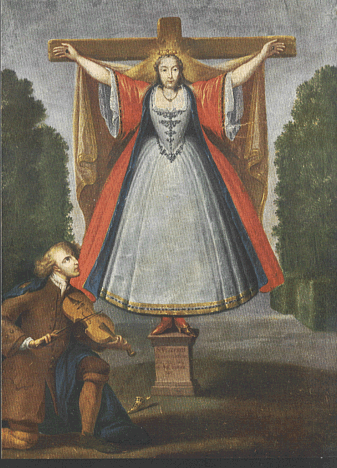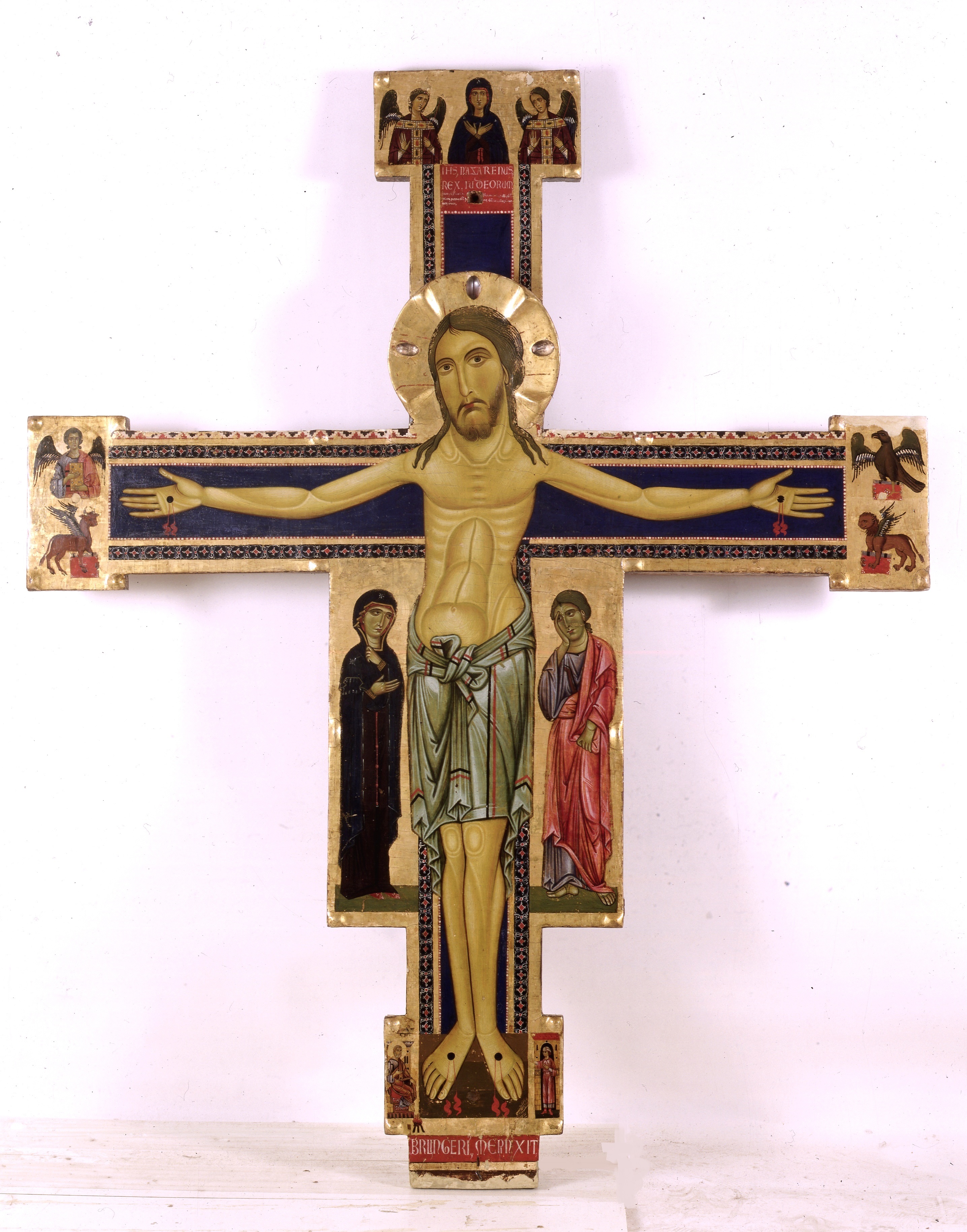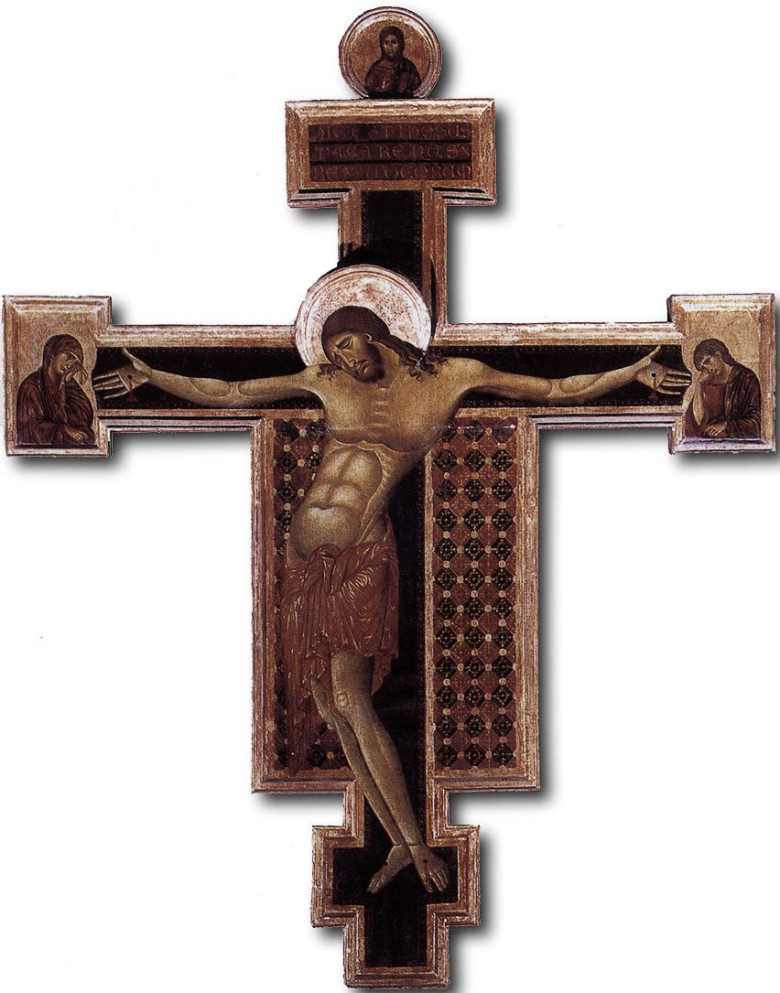 The mention of lho Italian've already given the Heilige Kummernis. now the English quotation explains a similar version, sometimes with more details.
The mention of lho Italian've already given the Heilige Kummernis. now the English quotation explains a similar version, sometimes with more details. I dwell on important detail that I had spoken: the famous and revered "Holy Face of Lucca (photo 1) has many features that relate to what has been translated into Italian as" Santa Liberata, "although" Kummer "translated it means "trouble" (but there 'to say that it is sometimes referred to cme "Ohnkummer" or "without worry").
 The Holy Face has a blue robe and golden belt long as in the ancient representations of the saint. Sumptuous dress (as her rich family, not as Jesus on the cross), but another detail su cui ancora devo approfondire ma che ritorna anche nelle rappresentazioni di lei: un semicerchio attorno all'intera figura , che finisce, ai due lati, con dei gigli(foto 2 e 4). In epoca romanica porta la corona.
The Holy Face has a blue robe and golden belt long as in the ancient representations of the saint. Sumptuous dress (as her rich family, not as Jesus on the cross), but another detail su cui ancora devo approfondire ma che ritorna anche nelle rappresentazioni di lei: un semicerchio attorno all'intera figura , che finisce, ai due lati, con dei gigli(foto 2 e 4). In epoca romanica porta la corona. For those who do not know the story, here is the Catholic Encyclopaedia:

[quote]
A fabulous female saint known also as UNCUMBER, KUMMERNIS, KOMINA, COMERA, CUMERANA, HULFE, ONTCOMMENE, ONTCOMMER, DIGNEFORTIS, EUTROPIA, REGINFLEDIS, LIVRADE, LIBERATA, etc.
The legend makes her a Christian daughter of a pagan King of Portugal. In order to keep her vow of chastity, she prayed God to disfigure her body, that she might evade
 the command of her father to marry a pagan prince. God caused a beard to grow on her chin, whereupon her father had her crucified. Connected with this legend is the story
the command of her father to marry a pagan prince. God caused a beard to grow on her chin, whereupon her father had her crucified. Connected with this legend is the story of a destitute fiddler to whom, when he played before her image (or before her crucified body), she gave one of her golden boots. Being condemned to death for the theft of the boot, he was granted his request to play before her a second time, and, in presence of all, she kicked off her other boot, thus establishing his innocence.
The legend is not a Christian adaptation of the Hermaphroditus of Greek mythology or of other androgynous myths of pagan antiquity, as it cannot be traced back further than the fifteenth century. It rather originated from a misinterpretation of the famous "Volto Santo" of Lucca, a representation of the crucified Saviour, clothed in a long tunic, His eyes wide open, His long hair falling over His shoulders, and His head covered with a crown. This crucifix, popularly believed to be the work of Nicodemus, is preserved in the Basilica of Lucca and highly venerated by the people. In the early Middle Ages it was common to represent Christ on the cross clothed in a long tunic, and wearing a royal crown; but since the eleventh century this practice has been discontinued. Thus it happened that copies of the "Volto Santo" of Lucca, spread

pictures of a woman who had suffered martyrdom.
invokes the saint in the hour of death will die ohne Kummer, without anxiety. When the cult of St. Wilgefortis began to spread in the fifteenth and sixteenth centuries, her name found its way into various breviaries and martyrologies. Thus a breviary,

Wilgefortis The name is derived from Virgo fortis Usually, But Schnurer has recently shown Wilgefortis That is Probably a corruption of Hilge Vartz (Vartz, Fratze, face), "Holy Face". Would this corroborated the opinion That the legend Originated in the "Holy Face". The old name Uncumber Inglese, as the German Also Oncommer and Their equivalents in other languages, rose from the popular belief That Every one who








